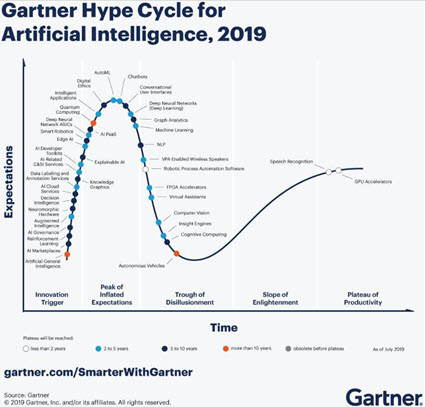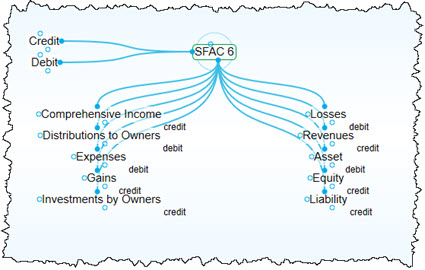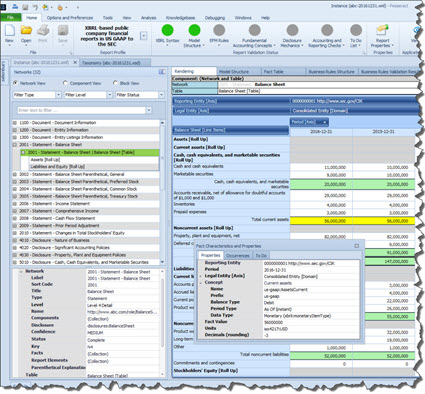BLOG: Digital Financial Reporting
This is a blog for information relating to digital financial reporting. This blog is basically my "lab notebook" for experimenting and learning about XBRL-based digital financial reporting. This is my brain storming platform. This is where I think out loud (i.e. publicly) about digital financial reporting. This information is for innovators and early adopters who are ushering in a new era of accounting, reporting, auditing, and analysis in a digital environment.
Much of the information contained in this blog is synthasized, summarized, condensed, better organized and articulated in my book XBRL for Dummies and in the chapters of Intelligent XBRL-based Digital Financial Reporting. If you have any questions, feel free to contact me.
Entries from November 1, 2019 - November 30, 2019
VentureBeat: Is AI in a golden age or on the verge of a new winter?
A VentureBeat article by Gary Grossman, Is AI in a golden age or on the verge of a new winter?, points out some of the growing negative feedback about artificial intelligence. This is not new. Others have pointed out that AI is a fragile house of cards that what people are creating tend to be cheap parlor tricks and that 81% of business leaders don't understand AI. The VentureBeat article provides the Gartner Hype Cycle for Artificial Intelligence:
Who knows. Maybe we are in the midst of an "AI winter" or maybe we are on the verge of something really big. Picking wrong can have grave consequences.
In my humbel opinion, certain aspects of financial reporting are going to contribute to AI and financial reporting entering a golden age. Here is why:
- Key to AI is semantics and financial reporting is rich with standard semantics. The mathematics of double entry accouting were created in about 1211, documented in 1494, details were built out over the past 100 years, and international financial reporting standards have existed since 1975.
- Key to AI is some syntax, preferably a standard syntax. XBRL provided that beginning in 1999 and the standards have been stable since 2003.
- Experimentation has been taking place since 2009 when the U.S. SEC started accepting XBRL-based reports; now we have about 6,000 economic entities X four reports per year X 10 years of reports. That is excellent information even though there are some quality issues with reported information. Knowlegeable people can easily distinguish the good from the bad.
- We already have working proof of concepts that solve real issues for financial reporting. No one really disputes that fact that financial reporting is ineffecient.
- Because XBRL-based reports are "digital", specific report information can be addressed which opens up the possibility of leveraging Lean Six Sigma philosophies and technicques to automate quality control.
- Immutable digital distributed ledgers make all of this even more interesting.
Where are you on the AI Ladder?
TheBrain: Imagining How Financial Reporting Taxonomies Will Ultimately Work
Someone made me aware of an application called TheBrain. You can try the online version by just getting a login. You can download a locally installable version and you get a free trial.
What is interesting about TheBrain is that it helps you get your head around how knowledge such as a financial reporting taxonomy will be represented and used in the future.
I created two prototypes. The first is FASB's SFAC 6 represented as best as I could within TheBrain. I cannot get the relations expressed that I want expressed (i.e. all of this information). I don't quite understand how to use "tags" and "types" as well as I need to. But, the thing about generalized tools like this is that they are harder to user that special purpose tools.
What I suspect is going to happen is that some smart software vendor is going to grasp that if they can get away from the XBRL syntax, deal with meaning and logic instead, and create a specialized tool for financial reporting then they will have something useful and valuable.
The second prototype is SBRM Logical Conceptulization of a Business Report using TheBrain. (This)
Let me see what I can come up with. Worst case is that I will understand the shortcomings of TheBrain and how to overcome them. Maybe I will help build something specific for financial reporting.
Software similar to TheBrain includes XMind, MindMeister, FreeMind, MindManager, Mindomo, and a bunch of other such applications.
OMG Standard Business Report Model (SBRM) Initial Submission Information
Earlier this week, the official first submission toward the OMG Standard Business Report Model (SBRM) RFP was made. As it turns out, there were no other teams/organizations that chose to create an alternative submission and so there will be only one team responding to this SBRM RFP. I am on that submission team as are several others from the XBRL community and we have no competition.
Our submission will be based on initial work that I had created for financial reporting. Anything related specifically to financial reporting (which is not much) will be stripped out as SBRM relates to general business reporting.
However, I have also updated my prior open framework and will be evolving that to the global standard SBRM logical conceptualization of a business report. I will be tuning that SBRM model specifically for financial reporting. What I am providing (see below) is NOT the official Standard Business Report Model (SBRM) submission version yet, I am trying to get that information to be made public and that could happen soon.
However, what I have is extremely similar, will ultimately be the same, and therefore this information is very useful if you want to understand or comment on SBRM. It is my intent to make information about SBRM that is very approachable to business professionals.
Here is what I have thus far:
- The Big Picture: This provides the “big picture”, a summary of the TERMS and ASSOCIATIONS between the terms. This is NOT in UML or OWL yet, but those representations that technical people need will be part of the official submission and I cannot provide that currently.
- Overview: If you go to this page and go to the first bullet point titled "Overview" you can get all the details that you want about SBRM to understand it or to provide comments to improve it.
Understanding XBRL-based Digital Financial Reports in Six Images
Understanding XBRL-based Digital Financial Reports in Six Images is an effort to condence the volume of information that I have into easy to absorb sound bites.
Let me know how I do. I will keep plunking away and will eventually figure it out.
More on Logic Programming and Prolog Examples
In a prior post I talked about logic programming. Here is more including two working examples that I created in Prolog with the help of someone on the SWI-Prolog list.
First, here are the two Prolog examples:
- Accounting Equation: Assets = Liabilities + Equity. (SWISH Output)
- FASB SFAC 6, Elements of Financial Statements: Represents the 10 elements of financial statements and relations defined by the FASB in SFAC 6. (SWISH Output)
Both of these will run using this online SWI-Prolog application (click on "Program"). For more information including documentation, tutorials, examples, etc.; go to the SWI Prolog web site.
What is particularly interesting is the SWISH "wrapper" that you have on top of SWI-Prolog.
Something else that I ran across that is similar to SWISH is LogicBlox. They also have an online application, LogiQL Playground, that provides similar functionality using a similar strategy and underlying syntax which is Datalog. Here is more information on LogicBlox.
There seems to be an entire community interested in Prolog creating extensions. For example, SimGen.
As I understand it, this is a Prolog based accounting system. What would be REALLY interesting would be to adjust that Prolog system to handle XBRL and so it will output an XBRL-based financial statement.
###################################
Post to SWI-Prolog Forum related to Creating the Two Prototypes Above
Google's Yedalog which is an extension of Datalog
Visual JavaScript (visjs.org)




